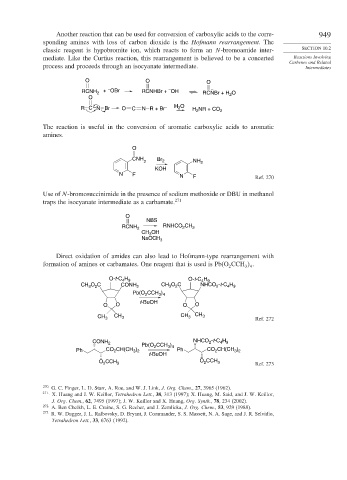Page 973 - Advanced Organic Chemistry Part B - Reactions & Synthesis
P. 973
Another reaction that can be used for conversion of carboxylic acids to the corre- 949
sponding amines with loss of carbon dioxide is the Hofmann rearrangement. The
classic reagent is hypobromite ion, which reacts to form an N-bromoamide inter- SECTION 10.2
mediate. Like the Curtius reaction, this rearrangement is believed to be a concerted Reactions Involving
Carbenes and Related
process and proceeds through an isocyanate intermediate. Intermediates
O O O
–
–
RCNH 2 + – OBr RCNHBr + OH RCNBr + H 2 O
O
– O
R C N Br O C N R + Br – H 2 H 2 NR + CO 2
The reaction is useful in the conversion of aromatic carboxylic acids to aromatic
amines.
O
CNH Br 2
2 NH 2
KOH
N F N F Ref. 270
Use of N-bromosuccinimide in the presence of sodium methoxide or DBU in methanol
traps the isocyanate intermediate as a carbamate. 271
O
NBS
RCNH 2 RNHCO 2 CH 3
CH OH
3
NaOCH 3
Direct oxidation of amides can also lead to Hofmann-type rearrangement with
formation of amines or carbamates. One reagent that is used is Pb(O CCH .
2 3 4
O-t-C H O-t-C H
4 9
4 9
CH O C CONH 2 CH 3 O C NHCO -t-C H
2
4 9
3
2
2
Pb(O CCH )
3 4
2
t-BuOH
O O O O
CH 3 CH 3 CH 3 CH 3 Ref. 272
NHCO -t-C H
CONH 2 2 4 9
Pb(O CCH )
2
3 4
Ph CO CH(CH ) Ph CO CH(CH )
2
3 2
2
3 2
t-BuOH
O CCH 3 O CCH 3 Ref. 273
2
2
270 G. C. Finger, L. D. Starr, A. Roe, and W. J. Link, J. Org. Chem., 27, 3965 (1962).
271
X. Huang and J. W. Keillor, Tetrahedron Lett., 38, 313 (1997); X. Huang, M. Said, and J. W. Keillor,
J. Org. Chem., 62, 7495 (1997); J. W. Keillor and X. Huang, Org. Synth., 78, 234 (2002).
272 A. Ben Cheikh, L. E. Craine, S. G. Recher, and J. Zemlicka, J. Org. Chem., 53, 929 (1988).
273
R. W. Dugger, J. L. Ralbovsky, D. Bryant, J. Commander, S. S. Massett, N. A. Sage, and J. R. Selvidio,
Tetrahedron Lett., 33, 6763 (1992).

